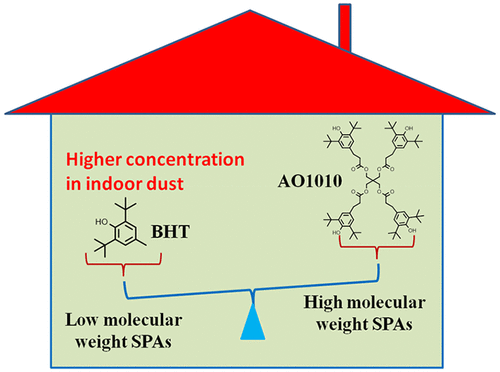当前位置:
X-MOL 学术
›
Environ. Sci. Technol. Lett.
›
论文详情
Our official English website, www.x-mol.net, welcomes your
feedback! (Note: you will need to create a separate account there.)
Novel High Molecular Weight Synthetic Phenolic Antioxidants in Indoor Dust in Toronto, Canada
Environmental Science & Technology Letters ( IF 8.9 ) Pub Date : 2020-01-03 , DOI: 10.1021/acs.estlett.9b00715 Runzeng Liu 1 , Scott A. Mabury 1
Environmental Science & Technology Letters ( IF 8.9 ) Pub Date : 2020-01-03 , DOI: 10.1021/acs.estlett.9b00715 Runzeng Liu 1 , Scott A. Mabury 1
Affiliation

|
Synthetic phenolic antioxidants (SPAs) are additives that are used to retard oxidative degradation in polymers, extending their lifespans. Previous studies have mainly focused on the pollution and toxicity risk of low molecular weight SPAs such as 2,6-di-tert-butyl-4-methylphenol (BHT, C15H24O). In this study, 10 novel high molecular weight SPAs were investigated, along with BHT. Surprisingly, all 10 high molecular weight SPAs, as well as BHT, were detected in indoor dust collected in Toronto, with ∑SPAs of 239–2.13 × 105 ng/g (geometric mean (GM): 1.77 × 103 ng/g). Although BHT (GM: 749 ng/g) was the primary congener in the indoor dust, contributing 55.2% to ∑SPAs, the 10 newly identified high molecular weight SPAs, such as pentaerythritol tetrakis(3-(3,5-di-tert-butyl-4-hydroxyphenyl)propionate) (AO1010, C73H108O12, GM: 146 ng/g), octadecyl-3-(3,5-di-tert-butyl-4-hydroxyphenyl)-propionate (AO1076, C35H62O3, GM: 76.4 ng/g), and triethylene glycol bis(3-tert-butyl-4-hydroxy-5-methylphenyl)propionate (AO245, C34H50O8, GM: 28.8 ng/g), also contributed substantially to ∑SPAs (44.8%). The newly identified high molecular weight SPAs were predicted to have intermediate to high toxicity risks by Toxtree. The high molecular weight SPAs are likely hydrolytically stable in indoor environments, as their hydrolysis product was detected seldomly and only at low concentrations. To our knowledge, this is the first study reporting the occurrence of eight high molecular weight SPAs in indoor environments, among which seven congeners were detected for the first time in any environmental samples. Further studies on SPAs should include these newly identified high molecular weight SPAs, particularly AO1010, AO1076, and AO245.
中文翻译:

加拿大多伦多室内尘埃中的新型高分子量合成酚类抗氧化剂
合成酚类抗氧化剂(SPA)是用于阻止聚合物中氧化降解,延长其使用寿命的添加剂。先前的研究主要集中在低分子量SPA的污染和毒性风险上,例如2,6-二叔丁基-4-甲基苯酚(BHT,C 15 H 24 O)。在这项研究中,与BHT一起研究了10种新型高分子量SPA。令人惊讶的是,在多伦多收集的室内灰尘中检测到所有10种高分子量SPA和BHT,其∑SPA为239–2.13×10 5 ng / g(几何平均值(GM):1.77×10 3ng / g)。虽然BHT(GM:749纳克/克)是在室内灰尘主同类,贡献55.2%至ΣSPAs,10楼新鉴定的高分子量的SPA,如季戊四醇四(3-(3,5-二-叔-4-羟基苯基丁基丙酸酯)(AO1010,C 73 H 108 O 12,GM:146 ng / g),十八烷基-3-(3,5-二叔丁基-4-羟基苯基丙酸酯)(AO1076 ,C 35 H 62 O 3,GM:76.4 ng / g)和三甘醇双(3-叔丁基-4-羟基-5-甲基苯基)丙酸酯(AO245,C 34 H 50 O 8),GM:28.8 ng / g),也对ΣSPAs的贡献很大(44.8%)。Toxtree预测新鉴定的高分子量SPA具有中等到高毒性风险。高分子量SPA在室内环境中可能具有水解稳定性,因为很少会检测到它们的水解产物,并且仅在低浓度下才能检测到。据我们所知,这是第一个报告在室内环境中出现8个高分子量SPA的研究,其中在任何环境样品中首次检测到7个同类物。对SPA的进一步研究应包括这些新近鉴定的高分子量SPA,尤其是AO1010,AO1076和AO245。
更新日期:2020-01-04
中文翻译:

加拿大多伦多室内尘埃中的新型高分子量合成酚类抗氧化剂
合成酚类抗氧化剂(SPA)是用于阻止聚合物中氧化降解,延长其使用寿命的添加剂。先前的研究主要集中在低分子量SPA的污染和毒性风险上,例如2,6-二叔丁基-4-甲基苯酚(BHT,C 15 H 24 O)。在这项研究中,与BHT一起研究了10种新型高分子量SPA。令人惊讶的是,在多伦多收集的室内灰尘中检测到所有10种高分子量SPA和BHT,其∑SPA为239–2.13×10 5 ng / g(几何平均值(GM):1.77×10 3ng / g)。虽然BHT(GM:749纳克/克)是在室内灰尘主同类,贡献55.2%至ΣSPAs,10楼新鉴定的高分子量的SPA,如季戊四醇四(3-(3,5-二-叔-4-羟基苯基丁基丙酸酯)(AO1010,C 73 H 108 O 12,GM:146 ng / g),十八烷基-3-(3,5-二叔丁基-4-羟基苯基丙酸酯)(AO1076 ,C 35 H 62 O 3,GM:76.4 ng / g)和三甘醇双(3-叔丁基-4-羟基-5-甲基苯基)丙酸酯(AO245,C 34 H 50 O 8),GM:28.8 ng / g),也对ΣSPAs的贡献很大(44.8%)。Toxtree预测新鉴定的高分子量SPA具有中等到高毒性风险。高分子量SPA在室内环境中可能具有水解稳定性,因为很少会检测到它们的水解产物,并且仅在低浓度下才能检测到。据我们所知,这是第一个报告在室内环境中出现8个高分子量SPA的研究,其中在任何环境样品中首次检测到7个同类物。对SPA的进一步研究应包括这些新近鉴定的高分子量SPA,尤其是AO1010,AO1076和AO245。


















































 京公网安备 11010802027423号
京公网安备 11010802027423号